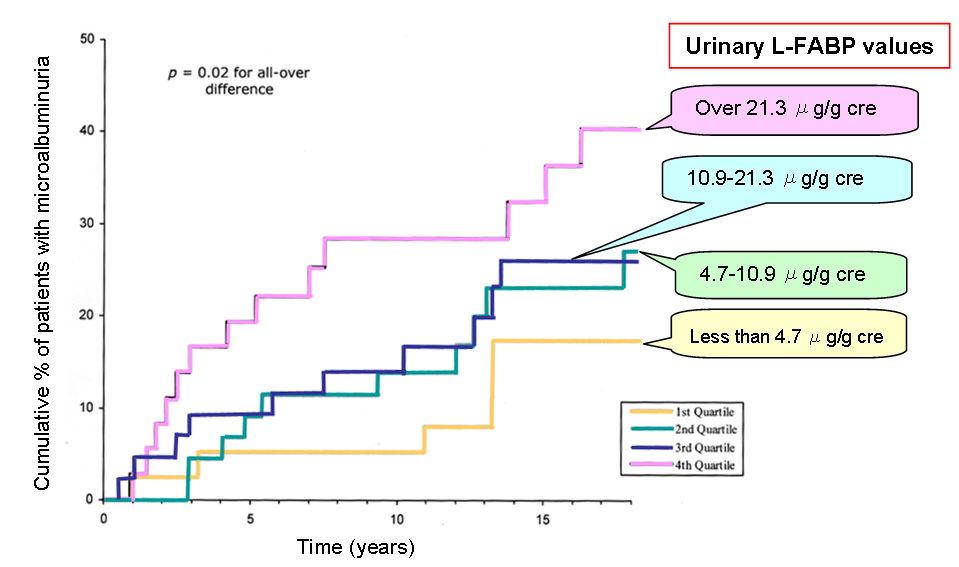The clinical significance of urinary L-FABP level in diabetic patients
The study on Type 1 diabetic patients shows that urinary L-FABP level increases with levels of albuminuria, from normoalbuminuria, microalbuminuria to macroalbuminuria and it is correlated with urinary albumin level. Also this study made clear the fact that ACE inhibitor which is one of treatment drug, decreases L-FABP level. [1]
The study of the progression of diabetic nephropathy among diabetic normoalbuminuria patients according to 4 different urinary L-FABP level groups

Fig. 2 extracted from Nielsen, SE. et al., Diabetes Care. 33(6), 2010.,
amended with L-FABP data.[2]
DATA
- Method
- Progression to nephropathy in 165 Type 1 Diabetic patients were followed for a median of 18 years and divided in 4 groups with different urinary L-FABP level
- Results
- Among normoalbumiuric type 1 diabetic patients, urinary L-FABP increase even before they develop microalbuminuria and more their initial urinary L-FABP level is high, more the risk of developing nephropathy and its progression is high. By measuring L-FABP level, the determination of patients with high risk of developing nephropathy.
The study on the diabetic nephropathy progress in patients with abnormal urinary albumin level

CMIC HOLDINGS Co., Ltd. internal data
DATA
- Method
- The development of nephropathy and its progress was determined in 104 type 2 diabetes patients followed during 4 years.
*The nephropathy progress means the increase of albumin in urine, transition to end stage renal failure and introduction to dialysis. - Results
- Among the patients with abnormal urinary albumin level and high urinary L-FABP level, the progression of diabetic nephropathy has been observed for 70% of them. By measuring urinary albumin and urinary L-FABP levels at the same time, the patients with high risk of nephropathy progression could be determined.
References
- [1] Nakamura, T. et al., Effect of Pitavastatin on Urinary Liver-Type Fatty Acid–Binding Protein Levels in Patients With Early Diabetic Nephropathy. Diabetes Care. 28(11): 2728-2732, 2005. PubMed
- [2] Nielsen, S.E. et al., Tubular and glomerular injury in diabetes and the impact of ACE inhibition. Diabetes Care. 32(9): 1684-1688, 2009. PubMed
- [3] Nielsen, S.E. et al., Urinary liver-type fatty acid-binding protein predicts progression to nephropathy in type 1 diabetic patients. Diabetes Care. 33(6): 1320-1324, 2010. PubMed
- [4] Kamijo-Ikemori, A. et al., Clinical significance of urinary liver-type fatty acid-binding protein in diabetic nephropathy of type 2 diabetic patients. Diabetes Care. 34(3): 691-696, 2011. PubMed